Every survival-themed reality show and backcountry influencer’s Instagram features a bushcraft knife. But what does that even mean, and how do you know which one to buy?
No worries, we’ve got you covered!
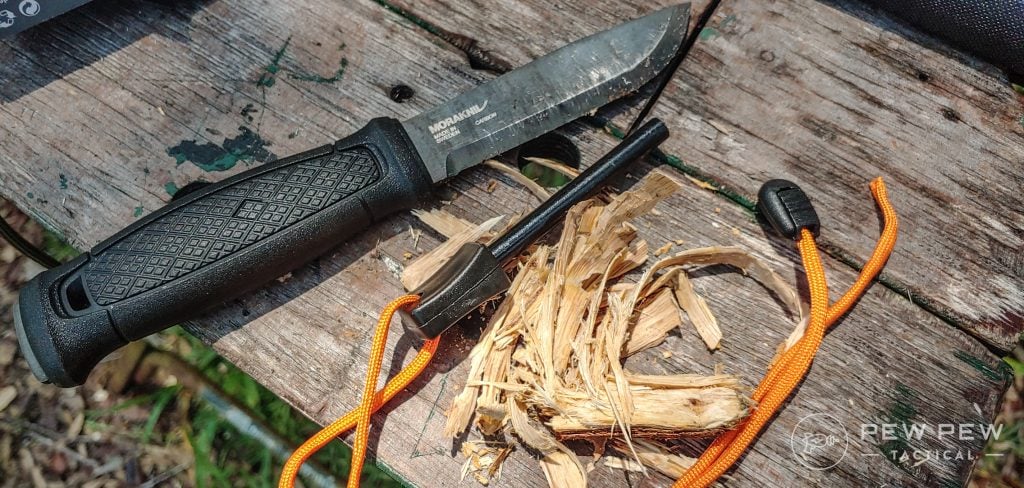
Read on to see the best bushcraft knives we’ve personally used (and still carry). By the end, you’ll also learn a little bit about what goes into making a knife good for bushcraft in the first place.
THE QUICK LIST
-
Best Overall
-
Best Premium
-
Best for Making Tools
-
Best for Beginners
-
Most Versatile
-
Best Traditional
Table of Contents
Loading…
Bushcraft Knife Comparison Chart
| Overall Length | Blade Length | Blade Grind | Blade Steel | Handle Material | Sheath Material | Price | |
| Morakniv Garberg | 9″ | 4.25″ | Scandi | Stainless | Polymer | Polymer | $60 |
| Helle Nord | 11.13″ | 5.8″ | Scandi | 14C28N | Curly birch | Leather | $249 |
| L.T. Wright GNS | 9.5″ | 4.25″ | Scandi with a micro bevel | O1 | Micarta | Leather | $220 |
| Condor Tool & Knife Bushlore Camp | 9.25″ | 4.25″ | Scandi | 1075 | Hardwood | Leather | $62 |
| ESEE-4 | 9″ | 4.5″ | Flat | 1095 | Micarta | Polymer | $119 |
| Ka-Bar Becker Kephart | 9.68″ | 5.13″ | Flat | 1095 | Walnut | Leather | $159 |
How We Tested the Best Bushcraft Knives
For this article, we gathered a bunch of bushcraft knives we’ve personally owned and tested here at Pew Pew Tactical. The entire Pew Pew Tactical team, as well as freelance writers, contributed to this review to offer different opinions based on performance, durability, and value.
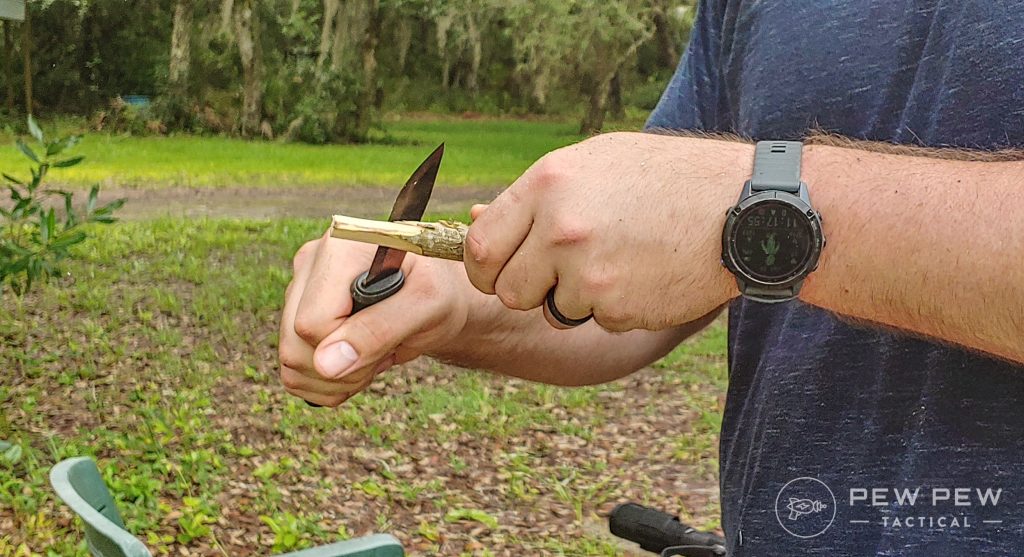
Testing included common bushcraft skills like cutting limbs, splitting logs, creating feather sticks, carving wood, and — of course — starting lots of campfires. These knives also proved their worth in the field because we’ve taken them on a bunch of camping and hiking trips, where they endured the elements and hard use.
Most of them have stuck around in our vehicles, camping packs, and go bags. They’re all solid choices, but not necessarily for the same reasons. Let us help you decide.
Best Bushcraft Knives
1. Morakniv Garberg – Best Overall
Prices accurate at time of writing
Prices accurate at time of writing
-
25% off all OAKLEY products - OAKLEY25
Copied! Visit Merchant
Pros
- 90-degree spine
- Variety of blade and handle combinations
- Fantastic value
Cons
- Polymer handle feels like a cost-cutting measure
Specs
- Overall Length: 9″
- Blade Length: 4.25″
- Blade Grind: Scandi
- Blade Steel: Stainless
- Handle Material: Polymer
- Sheath Material: Polymer
The Swedish company Morakniv has produced knives for well over a century, and they’ve got a winning formula for success.
Morakniv designs started for lumber use and eventually evolved into a very successful line of bushcraft knives.
The Garberg combines a full tang, a 90-degree spine for striking Ferro Rods, and a polymer handle that doesn’t require any special treatment.
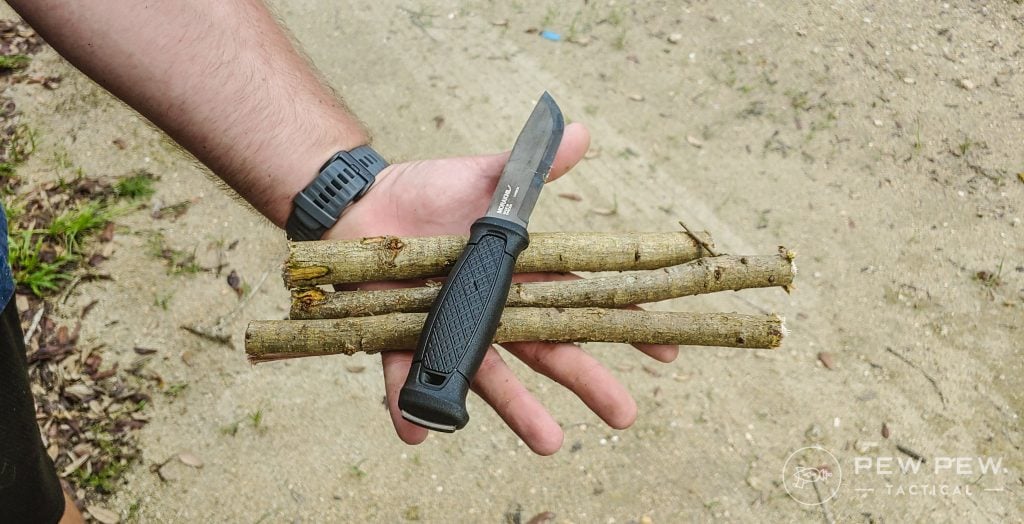
There are a bunch of options when it comes to steel type, blade finish, sheath material, and handle color. Have fun with it!
With a 4.25-inch blade, the Garberg provides plenty of Scandi grind edge for scooping big chunks off a piece of wood. You can easily carve, whittle, and drill with the clip-point blade.
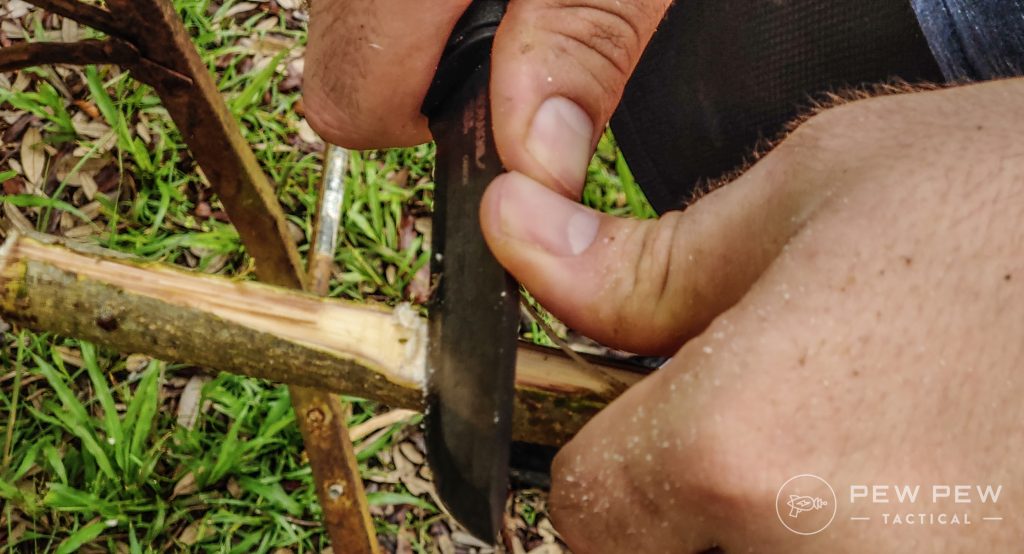
The polymer handle is super comfortable, and you don’t have to worry about maintaining it or exposing it to the elements.
This is one of the most well-respected and widely used bushcraft knives out there. Best of all, it’s super affordable! You don’t have to break the bank to get an excellent bushcraft knife.
2. Helle Nord – Best Premium
Prices accurate at time of writing
Prices accurate at time of writing
-
25% off all OAKLEY products - OAKLEY25
Copied! Visit Merchant
Pros
- Premium materials and quality
- Large enough for big projects
- Rugged, oversized blade
Cons
- Expensive
Specs
- Overall Length: 11.13″
- Blade Length: 5.8″
- Blade Grind: Scandi
- Blade Steel: Sleipner
- Handle Material: Curly birch
- Sheath Material: Leather
Let’s get something straight: there is no need to spend this much money on a bushcraft knife.
People buy Helle knives because they appreciate high-end Norwegian craftsmanship; not because they want the most practical tool for their money.
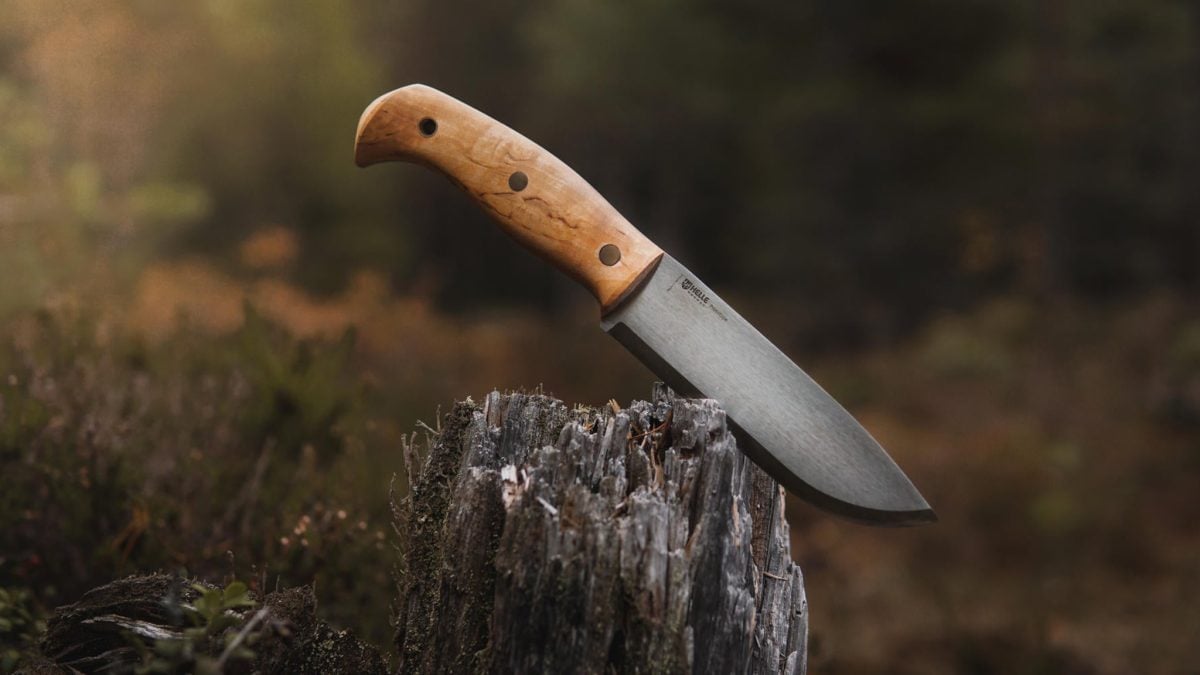
That said, the Helle Nord sure is a thing of beauty. The robust 14C28N steel blade is polished to a mirror shine, the curly birch is mesmerizing, and it’ll feel like Thor’s hammer in your hand.
But it’s not all show and no go.
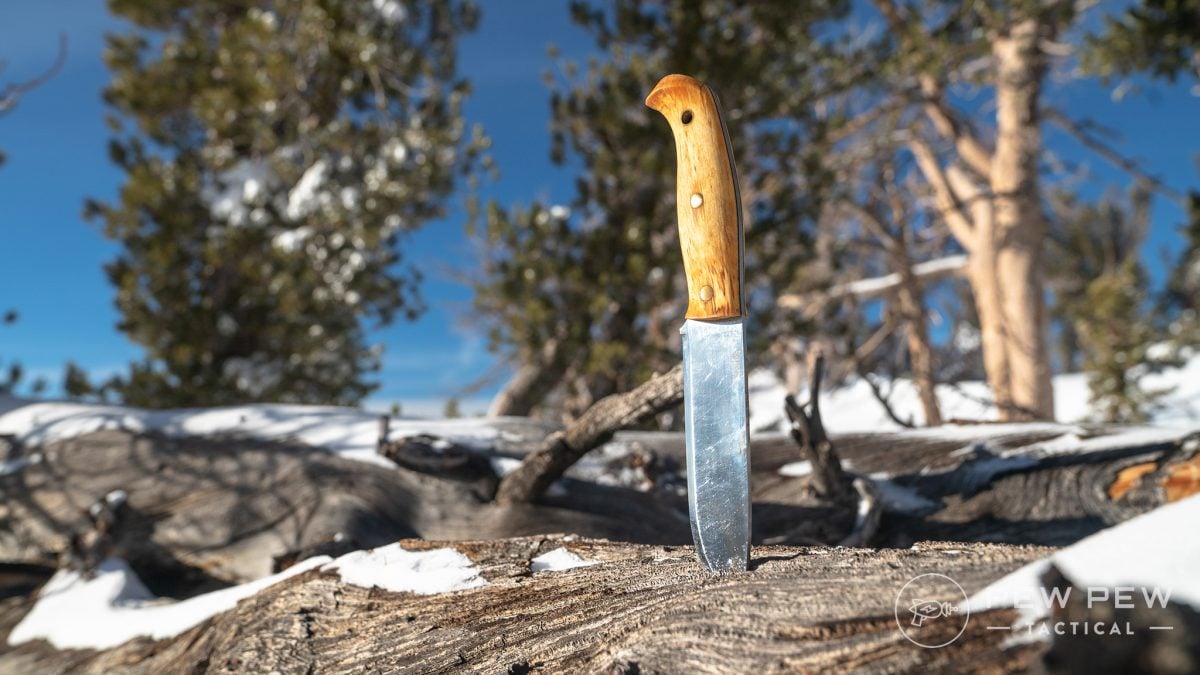
The hefty Nord blurs the line between a big knife and a small hatchet. If I can’t carry both into the mountains, I’m taking my Nord. I’ve used it to hack branches, split multiple Wisconsin winters’ supply of firewood, and even prepare dinner in a pinch (though it’s not my first choice for that kind of task).
The blade is super thick and the Scandi grind is rock solid. There is no need to baby this thing. The 90-degree spine works wonders with a ferro rod, too.
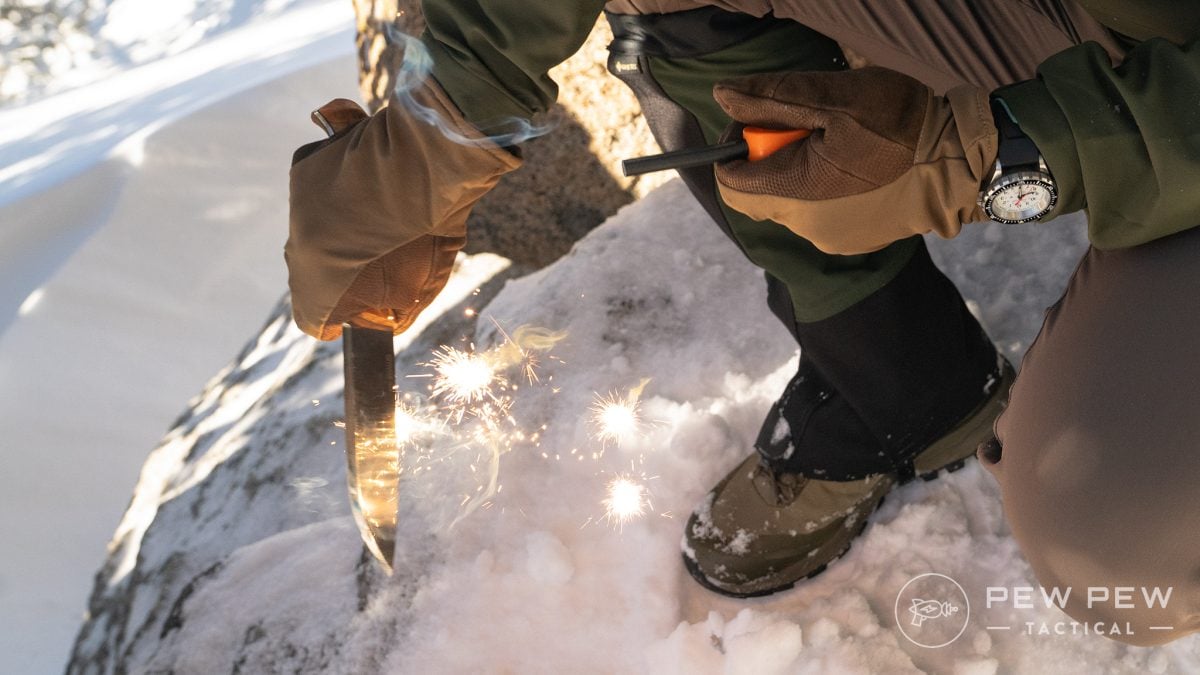
As with all wood handles, this one will require some upkeep. Be prepared to give it regular coats of beeswax or linseed oil to prevent it from drying out, absorbing water, and deteriorating.
3. L.T. Wright GNS – Best for Making Tools
Prices accurate at time of writing
Prices accurate at time of writing
-
25% off all OAKLEY products - OAKLEY25
Copied! Visit Merchant
Pros
- Durable O1 steel blade
- Versatile drop point
- Comfortable grip
Cons
- Poor corrosion resistance
- Somewhat expensive
Specs
- Overall Length: 9.5″
- Blade Length: 4.25″
- Blade Grind: Scandi with a micro bevel
- Blade Steel: O1
- Handle Material: Micarta
- Sheath Material: Leather
L.T. Wright is a knife designer who focuses largely on bushcraft blades.
His designs are among some of the best, and the GNS is the company’s flagship with all the features Wright prefers.
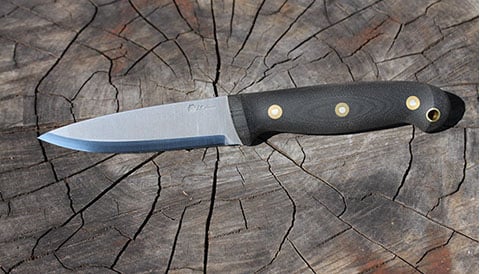
Want controversy? Ask a bushcraft forum if this is a Scandi grind. It sure looks like one — and many people people will tell you it is — but there’s a micro convex bevel at the very edge that will send purists into a tailspin.
The good news is that tiny bevel makes the blade easier to sharpen because you don’t have to remove nearly as much material as a true Scandi grind requires. The tradeoff is a relative decrease in durability, especially if you start splitting knotty firewood with it.
The blade’s drop point is an excellent feature for drilling holes and making other tools, which is useful in bushcrafting.
O1 steel is easy to sharpen and holds a good edge. It’s extremely strong and very capable.
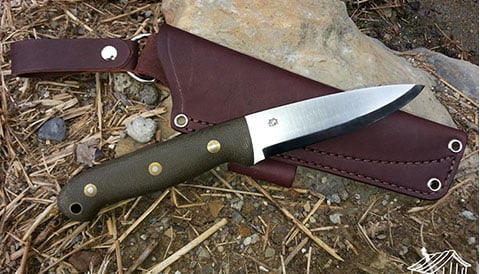
The GNS is a simple knife that makes it easy to make feather sticks, drill holes, whittle, and beyond.
The rounded Micarta grips give you a comfortable and well-textured design for hours and hours of work.
4. Condor Tool and Knife Bushlore Camp Knife – Best for Beginners
Prices accurate at time of writing
Prices accurate at time of writing
-
25% off all OAKLEY products - OAKLEY25
Copied! Visit Merchant
Pros
- Affordable
- Durable
- Scandi grind
Cons
- Lackluster edge retension
Specs
- Overall Length: 9.25″
- Blade Length: 4.25″
- Blade Grind: Flat
- Blade Steel: 1075
- Handle Material: Hardwood
- Sheath Material: Leather
If you want something a little more affordable than most, the Condor Tool and Knife Bushlore is a great starter.
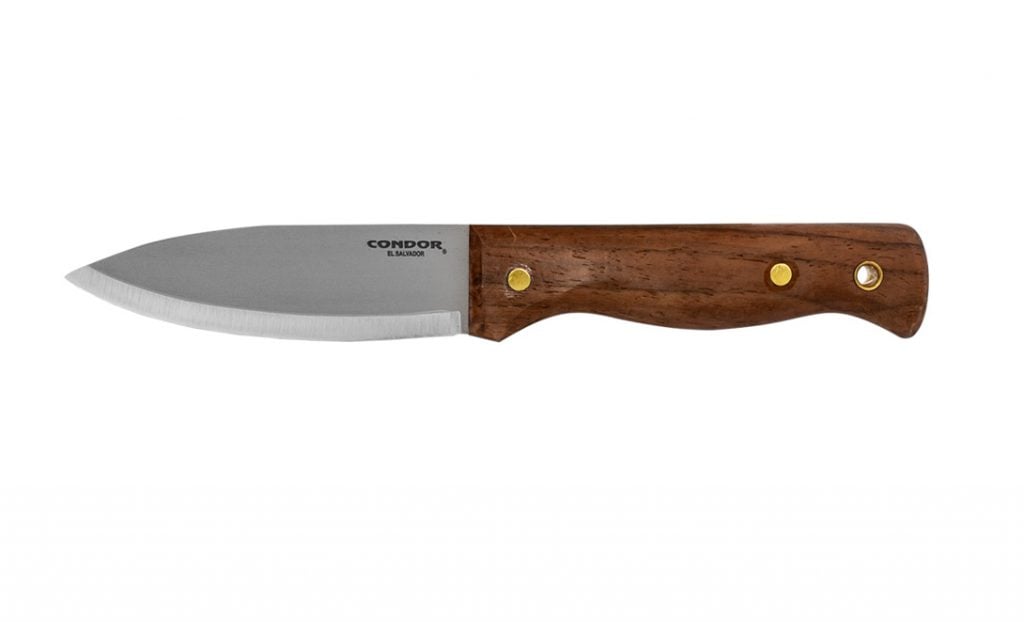
We get a 1075 high carbon steel blade that measures 4.25 inches long. Admittedly, 1075 isn’t the best steel for any particular use. During testing, we wished edge retention was a little better but it’s not a deal-breaker.
But it’s tough, and tough is important.
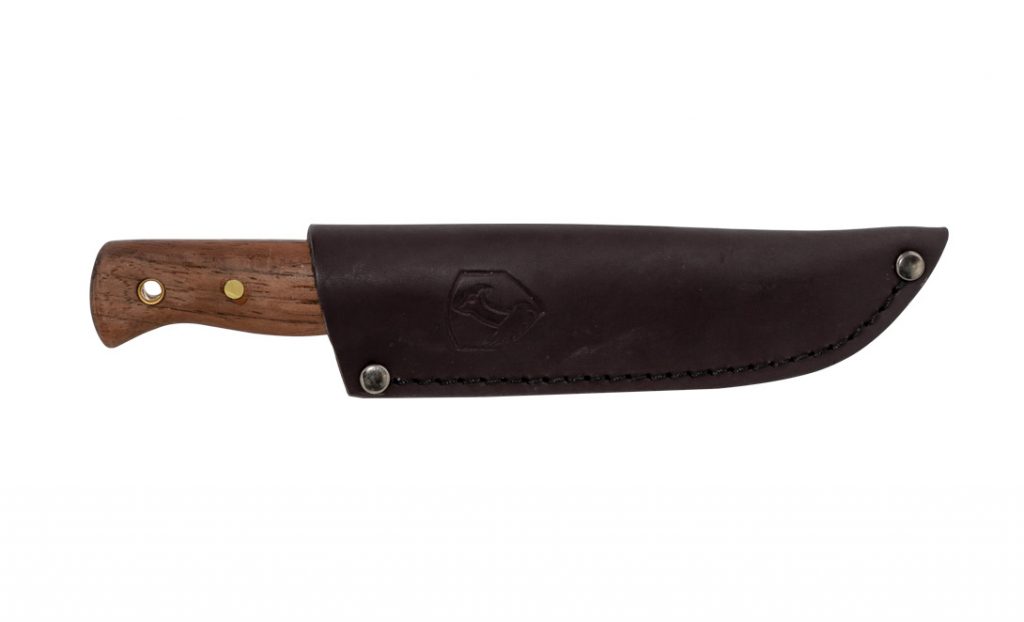
Beyond the blade, the Bushlore offers you a centerline point for easy drilling and digging-like tasks.
The comfortable wood handle looks nice and feels good in the hand, but it lacks a good grip texture for use with gloves.
5. ESEE-4 – Most Versatile
Prices accurate at time of writing
Prices accurate at time of writing
-
25% off all OAKLEY products - OAKLEY25
Copied! Visit Merchant
Pros
- Multiple blade and handle options
- Versatile enough for bushcraft and general use
- Rugged
Cons
- Somewhat expensive
- Not great for splitting wood
Specs
- Overall Length: 9″
- Blade Length: 4.5″
- Blade Grind: Flat
- Blade Steel: 1095
- Handle Material: Micarta
- Sheath Material: Polymer
When it comes to favoritism and bias, the ESEE-4 gets mine — full stop.
I love the ESEE-4, and it’s my current go-to bushcraft knife for sharpening my skills (pun intended).
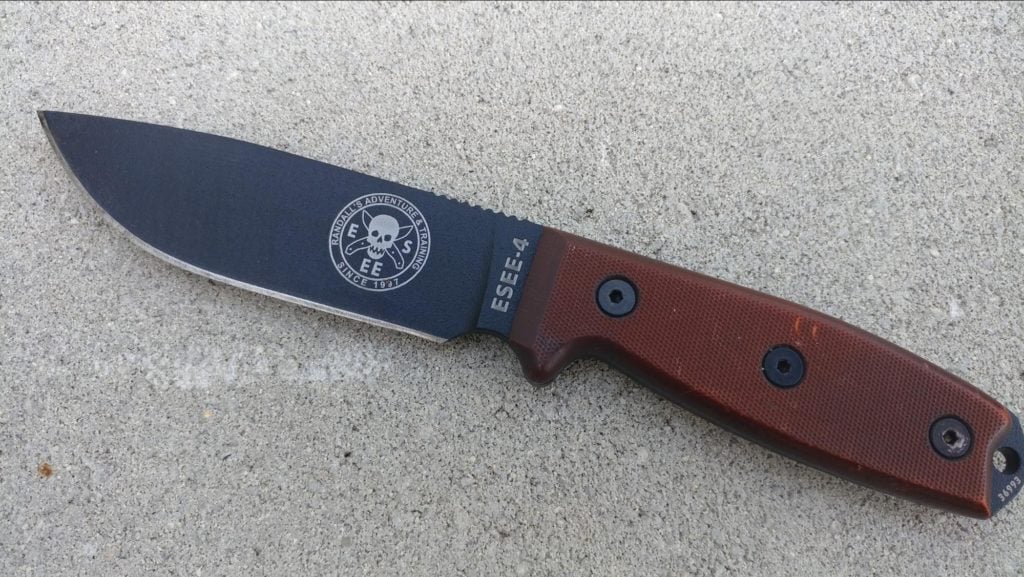
Randall’s Adventure company designs the ESEE series knives. Those cats are experienced bushcrafters, survivalists, and adventurers. Their knives reflect their experience.
The ESEE-4 packs a 4.5-inch blade in either 440C stainless steel or 1095 carbon steel, so buyers have options. Both materials provide a very strong, capable blade. It’s topped with a simple but versatile drop-point blade with a healthy belly for deep cuts.
It uses a flat grind that’s less sturdy but more precise than a Scandi grind. It’s certainly much better at slicing.
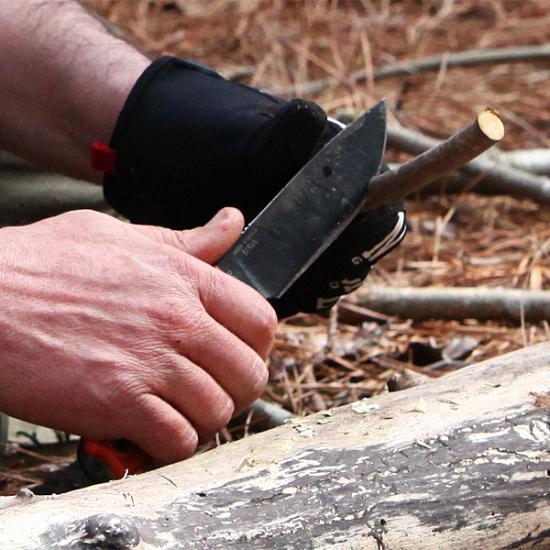
The ESEE-4 comes with a rounded G-10 handle that’s textured for a sure grip, but not so aggressive that it causes discomfort.
It’s one of my favorite knives and is a great all-around knife for survival, bushcrafting, fishing, hunting, and more.
What do you think of the ESEE-4? Give it a rating below.
6. KA-BAR Becker Kephart – Best Traditional
Prices accurate at time of writing
Prices accurate at time of writing
-
25% off all OAKLEY products - OAKLEY25
Copied! Visit Merchant
Pros
- It's a Buscrafting classic!
- Large, utilitarian blade
- Easy to sharpen
Cons
- Poor corrosion resistance
- Fairly expensive
Specs
- Overall Length: 9.68″
- Blade Length: 5.13″
- Blade Grind: Flat
- Blade Steel: 1095
- Handle Material: Walnut
- Sheath Material: Leather
Most bushcrafters consider Horace Kephart the father of modern bushcrafting and revere him as such. He designed the original Kephart knife — the perfect woodcraft tool.
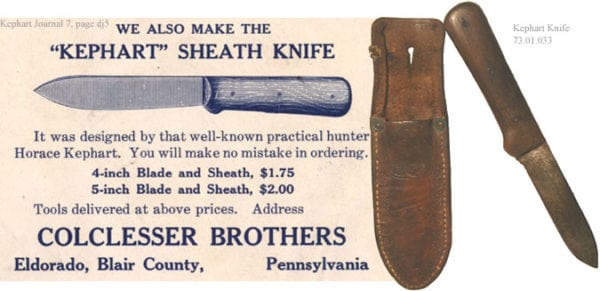
KA-BAR replicated the Kephart knife. This version wears a 5.13-inch blade with a centerline drop-point tip. This is a versatile tool for drilling holes and whittling with ease.
A healthy belly provides plenty of chopping and cutting room for bushcrafters.

It’s a practical knife for crafting tools, constructing shelters, and skinning game without much stress.
Heck, the spine is even square enough to strike ferro rods. It’s tough enough to baton firewood, too.
KA-BAR uses 1095 Cro-Van steel for this blade.
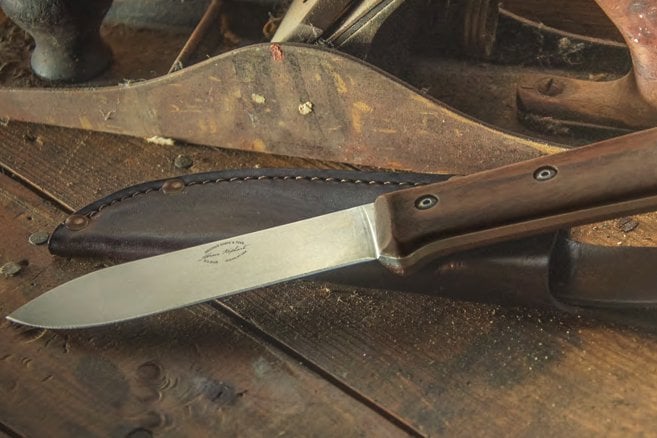
It’s incredibly easy to get this steel razor sharp, yet it’s surprisingly tough and very hard.
The biggest downside would be its corrosion resistance. It’s prone to rust, so keep it oiled after every use.
How to Pick the Best Bushcraft Knife
A dedicated bushcraft knife needs a few key design features to ensure it’s a rugged, investment-worthy knife that will survive years of abuse. Look for these while you’re making up your mind.
Full Tang
Check out the top and bottom of a knife’s handle; does it look like a steel sandwich? That’s a full tang.
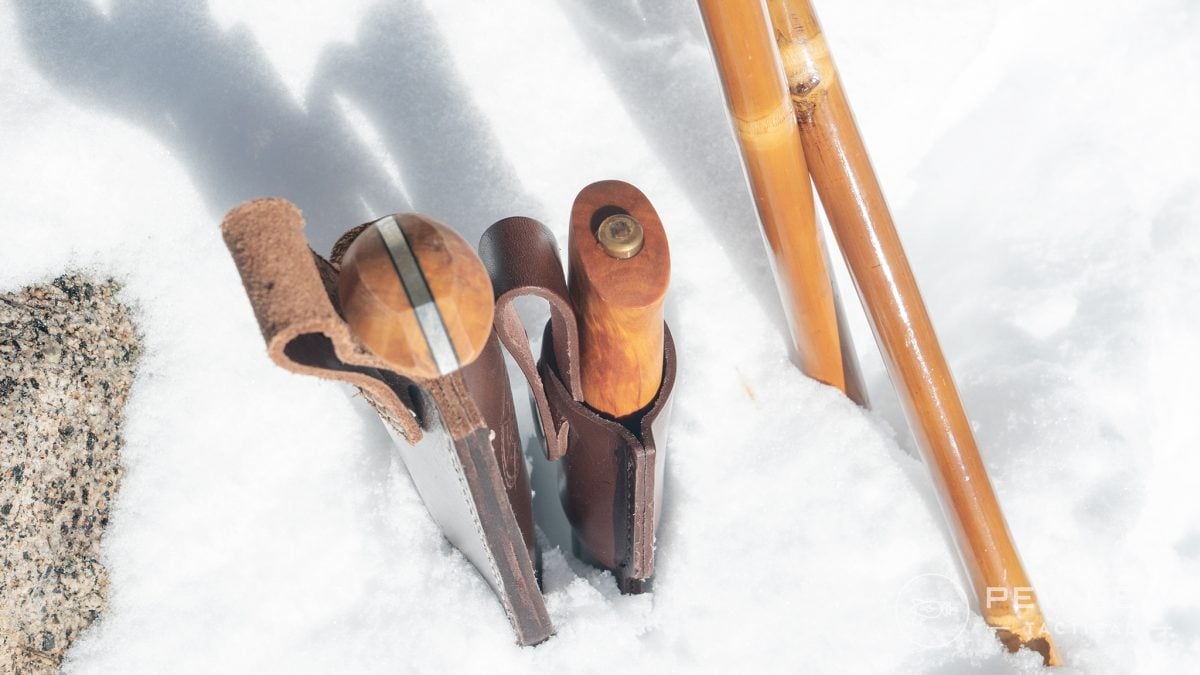
That’s a telltale sign but some full-tang knives cover up the steel with a wraparound grip. This doesn’t weaken the design and it adds a level of comfort, especially in the cold. The Morakniv Garberg is a great example.
Full tangs offer maximum durability, which is essential if you’re going to hammer your knife with a baton to split wood.
Stick tangs, folding knives, and other configurations have their roles but they’re not cut out for bushcraft.
Squared Spine
Squared spines are awesome for various tasks. It doesn’t need to be exactly 90 degrees, but that helps. The primary goal is to strike a ferro rod and create enough sparks to light a fire, even in bad weather.
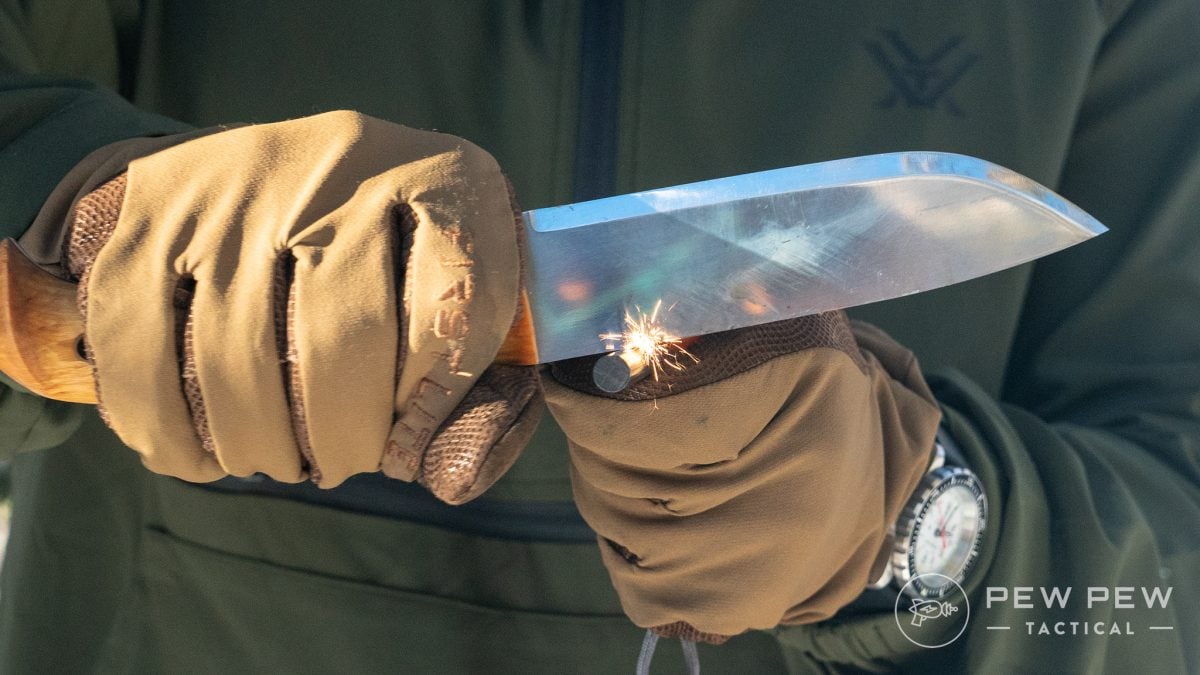
The square spine also makes it easier to shave extra-fine tinder off a piece of wood for fire-starting.
Stainless Steel vs. Carbon Steel
I don’t want to dive too far into this argument because it’s been raging for years (kind of like the 9mm vs. 45 ACP debate).
For bushcraft purposes, you can go either way. Carbon steel works better for striking ferro rods. Stainless steel doesn’t rust nearly as fast as carbon steel and it requires less maintenance. Choose your own adventure.
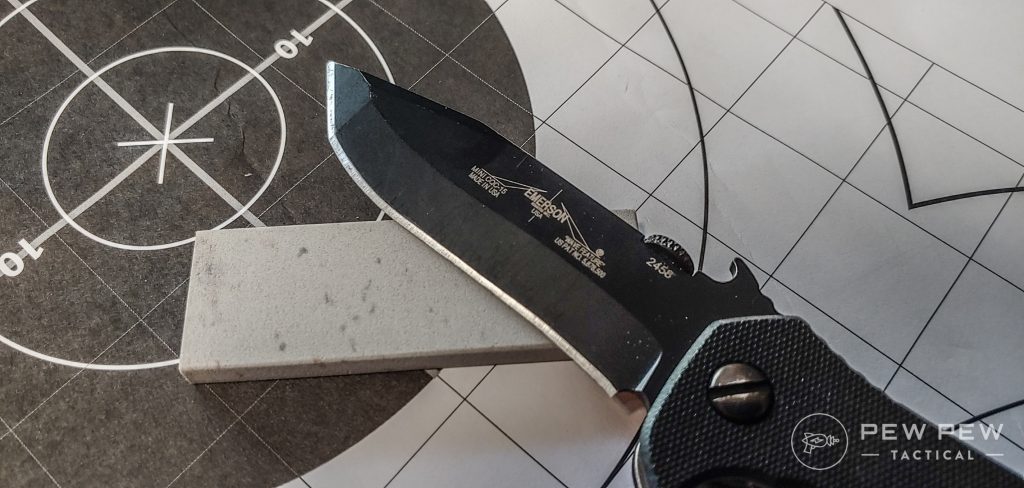
Honestly, it’s just best to evaluate your needs, your ability to sharpen a knife, and how much time you want to spend maintaining your gear.
Why Trust Pew Pew Tactical
Travis Pike has spent his entire life shooting and exploring outdoors. That started in a family that hunted every season they legally could, and continued during his time as an infantryman in the Marine Corps. Travis also loves knives and honing his bushcrafting skills. He’s a continual student, and he strives to educate himself to provide the best information possible to the readers of Pew Pew Tactical.
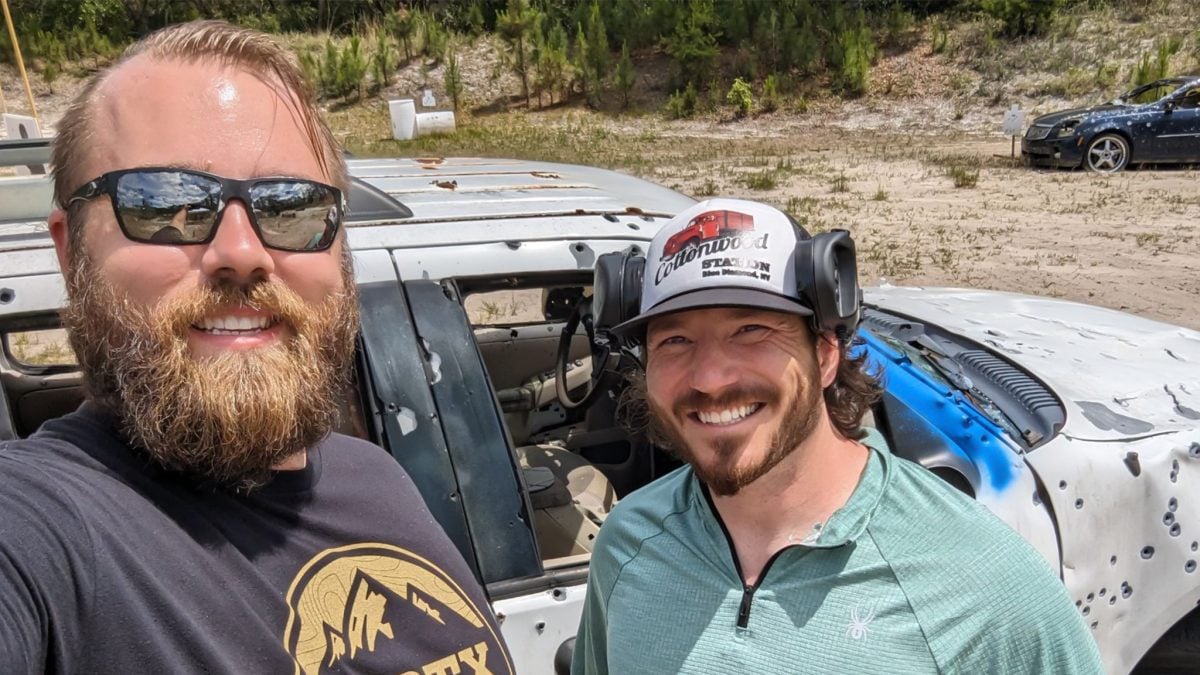
Editing this article is editor Scott Murdock. Scott is a Marine Corps veteran who competed and qualified as a rifle and pistol expert while in service. In addition to shooting, Scott has written for a variety of publications, testing, researching, and evaluating guns and gear. He brings that knowledge and skillset to this article, editing and fact-checking for accuracy.
Editor-in-Chief Jacki Billings runs our experienced team of reviewers. She is a National Rifle Association Basic Pistol Instructor as well as a member of the Society of Professional Journalists, ACES: Society for Editing, and the Professional Outdoor Media Association. Jacki has a bachelor’s degree in journalism and has worked as a media professional for close to 20 years, specializing in gun media for almost 10 years. With 2,000+ articles to her name, she uses her professional journalism and editing experience to set testing protocols and editorial standards for Pew Pew Tactical.
Final Thoughts
Bushcraft can be a challenging and rewarding hobby. Getting started is easy, mastery takes a lifetime, and it brings us closer to people who used the same skills centuries ago.
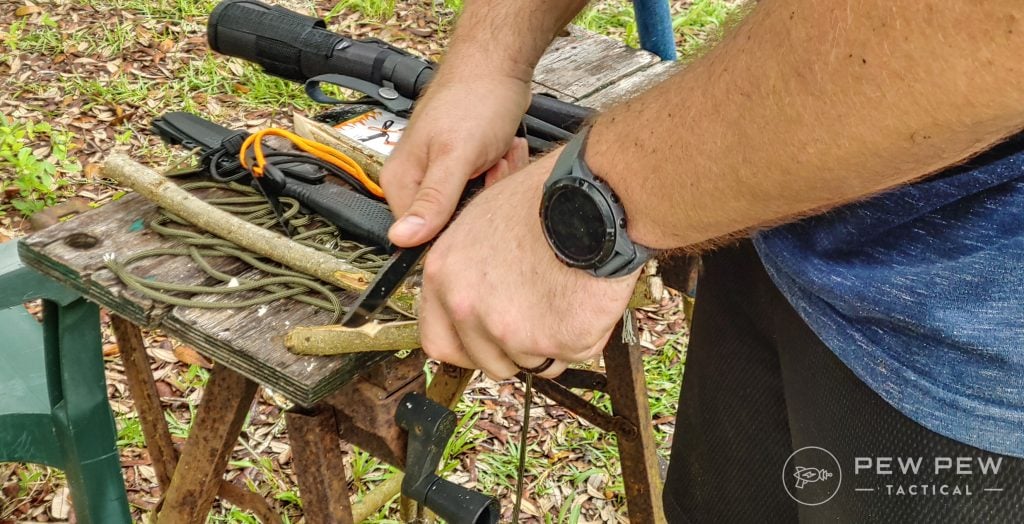
All you need to start is a bushcraft knife and a backyard — any of these knives will do the job.
What’s your preferred bushcraft knife? Let us know below! Ready to dive into more bushcrafting? Check out the five bushcraft skills you need to know.
Latest Updates
- January 2025: Removed the Ontario Bushcraft Field Knife. Added the Helle Nord.

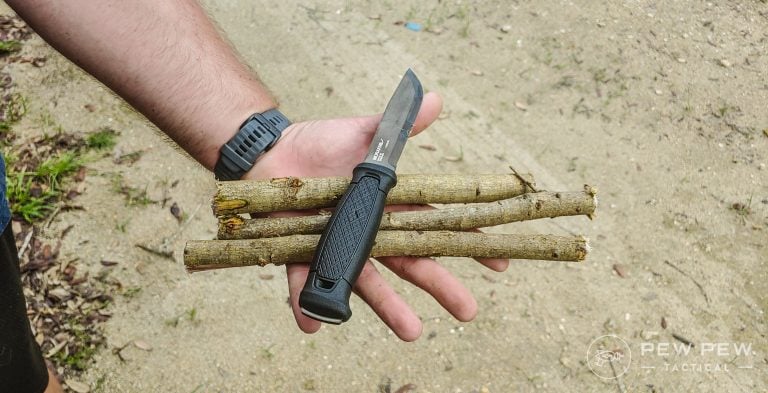
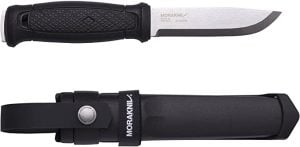

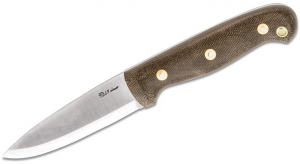




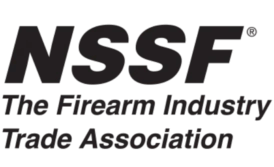











7 Leave a Reply
As disappointing as it may be, the early bushcrafters of the 1900s did recommend a kit of edges, not depending on just one knife. Hatchet, medium knife, long folder was one combination. Goes to what was considered necessary even in Lewis and Clark's day - they took a lot of each for trade goods and their own use. Hatchets, axes and tomahawks were plentiful and common in their journey.
Why baton your only knife in a survival situation - possibly breaking it - when a hatchet would be better? Canadian bush pilots are required by law to take an axe. Only military pilots take just one survival knife, considering there is little else to have on a vest and the odds of a "live" landing in the field are low.
I note there is a divide in blade grind with bushcraft knives, either the full flat - which processes meat better - or the barely ground edge on what appears to be flat stock. Its dominant with North Europe factory offerings and is even seen on their military knives. They also tend to be much lighter blades, which is rarely contrasted with the others.
Bushcraft knives as now sold weren't in the days of pioneering - people working their way west, or moving further from increased civilization had kits of tools, not just one. By forcing many jobs onto one knife, it's much the same as a set of multipliers, it does a lot of things but none well. That's where I part ways with them - BTW, it just dug up my Becker, and it's still a big heavy and blunt chopper but not real good on rabbits. As for handling wood, my old Ames hatchet still works more easily doing the same. I see bushcraft knives not as an answer for how pioneers did do the work, but as a fantasy tool for how people role play doing it now.
Having carried a fixed blade for most of my military career and while hunting, I've found a good field knife - not tactical, but one capable of field dressing deer - to be a good choice. That's a 4" flat grind with drop point, no choil, simple full tang handle that can be gripped by either hand up or down with no hotspots. It cuts - no hammers, or batons, or spears, or whatever. It's a tool for food prep as much as game prep. Simple carbon steel is all that is really needed, I already have the higher alloy on the sharper folding knife, anyway.
That and a light hatchet pretty much covers it. If you do carry a knife, you already know that two is one and one is none, we already know not to carry one way to make fire, but have another, same with a knife.
After searching and scrolling for a pure-quality bushcraft knife for my next tour. A knife attracted me a lot. It is made from high-quality materials, high-grade steel with a pure wooden handle. The sheath is robustly made from well-finished leather. I have been using it for 2 years. I always buy my knives from Almazan Knives. Almazan knives are one of the best sellers for pure quality knives.
I am a HUGE TOPS, Lord and Field, ESEEE, Buck N Bear, Condor and Spyderco fan…. BUT you all really need to check out and add these beauties and beasts too your lists!!
Holtzman’s Gorilla Survival Gear! He has very solid, high quality bushcraft knives and fire starting sets! And so much more! Nathan Holtzman really hits it out of the park and those of us who have had the privilege to own one of his bushcraft survival knives, camping knives, chopper, etc. would love too see his products out there and in more hands! Please check it out on Amazon under Holtzman’s Gorilla Survival Gear or on FB under Prepping & Bushcraft Backwoods to City Survival Community!! You won’t regret it!! Do a review or look up the reviews that have been done. I’m just that confident
I urge everyone buying a knife to buy American.
Bushcraft is building basic shelter and starting fires. (Good luck doing anything else with those wimpy-ass knives.) Have fun pretending matches and lighters don't exist. Enjoy pretending some sticks are enough shelter. Survival is everything else, for which a stouter blade will be necessary. Bushcraft is fine, just don't kid yourself.
If you had any kind of decent reading comprehension skills. You would of read that "bushcrafters" carry other tools like hatches and axes, so a larger knife isnt needed. Unless you're compensating for congenital shortcomings. However, if you only had one tool. A medium sized knife would certainly do more for you, especially a design that lends itself to doing multiple tasks well. A kukri knife or tracker comes to mind. But if you know what you're doing, you can batton smaller knives and use other skills to get big knife work done with a smaller sturdy fixed blade knife.
I’m guessing you missed the part about Bushcraft practitioners taking a hatchet, axe or machete with them to do hatchet, axe and machete work Rambo.